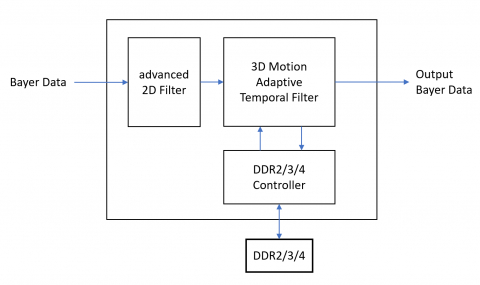Advanced 2D+3D Noise Reduction Core
Our noise reduction core removes noises using Motion adaptive temporal noise filter and 2D spatial noise filter. In bright lighting conditions, 2D spatial noise filter can remove noises effectively because the noise level is low. In low light conditions, the gain of the sensor is increased, so the noise level is increased significantly. In this case, noises can be removed more effectively by using temporal noise filter than 2D spatial noise filter. Our core uses the motion adaptive temporal filter (MATF) for 3D temporal filtering. The MATF uses a motion detection instead of a motion estimator that is used for motion compensated temporal filter (MCTF). In general, the performance of MCTF has been known to be better than MATF. But the motion estimator in MCTF often produces the false motion vectors that can reduce the performance of the noise filter. And also the window size of motion estimation should be very large to guarantee the good filtering performance, so the logic size of the motion estimator becomes so big. Our core minimizes ghost images with using new advanced 2D noise filter
查看 Advanced 2D+3D Noise Reduction Core 详细介绍:
- 查看 Advanced 2D+3D Noise Reduction Core 完整数据手册
- 联系 Advanced 2D+3D Noise Reduction Core 供应商
Block Diagram of the Advanced 2D+3D Noise Reduction Core

2D IP
- 2D Graphics Processor for Wearables/IoT
- High-performance 2D (sprite graphics) GPU IP combining high pixel processing capacity and minimum gate count.
- 2D (vector graphics) GPU IP Further advanced architecture for minimized CPU load and increased pixel performance in vector processing
- 2D (vector graphics) & 3D GPU IP A GPU IP combining 3D and 2D rendering features with high performance, low power consumption, and minimum CPU load
- 2D GPU / Vector Graphics Accelerator - D/AVE 2D
- 2.5D GPU / 2D & 3D Vector Graphics (OpenVG) Accelerator - D/AVE HD



